Ijraset Journal For Research in Applied Science and Engineering Technology
- Home / Ijraset
- On This Page
- Abstract
- Introduction
- Conclusion
- References
- Copyright
Comparative Study of Conventional Structure and Mivan Structure Using ETABS
Authors: M Ganga Jamuna, Dr. P Anuradha
DOI Link: https://doi.org/10.22214/ijraset.2024.63306
Certificate: View Certificate
Abstract
With rapid urbanization and industrialization, the demand for construction has surged to accommodate this expanding population. However, limited land availability has necessitated vertical construction over horizontal expansion. MIVAN technology has emerged as a viable solution, employing concrete instead of traditional masonry walls, particularly suitable for high-rise buildings. In this study, conventional and MIVAN structures with varying wall thicknesses is analyzed and compared using ETABS software with Response Spectrum analysis. Results show significant decreases in displacements, story drifts and time period in MIVAN structures, particularly with a wall thickness of 300mm for I-shaped structures. Additionally, MIVAN structures with 300mm walls exhibit higher story shear and stiffness, indicating better performance under seismic conditions compared to other shapes. Thus, MIVAN technology with 300mm walls in I-shaped structures offers superior seismic resilience in tall buildings.
Introduction
I. INTRODUCTION
Given the limited availability of land, vertical construction is now favored over horizontal expansion. For large-scale building projects, it is crucial to utilize advanced technologies that enable rapid construction while ensuring high quality. The use of aluminium has also emerged as a significant technique for efficient formwork, potentially accounting for up-to 25% of a building’s structure, and even more in bridge construction. Therefore, it is vital that the forms are meticulously designed to achieve cost-effectiveness without compromising on strength and efficiency. MIVAN technology is one such method employed for expedited construction.
A. MIVAN Technology
Mivan formwork system Mivan formwork system or Aluminium formwork system was developed by Mivan Company Ltd from Malaysia late 1990’s as a system for constructing mass housing project in developing countries. Compared with repetitive design, the system is built multiple times by structural elements, ensuring a fast and economical construction method. In this technique cast in place method is followed to cast load bearing walls using aluminum panels as formwork. Mivan is a pre-engineered aluminium formwork system where the precision is high because the beams, columns, walls, staircase and slabs formworks
The components of formwork are
- Wall components
- Beam components
- Deck components
- Other components
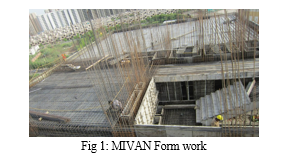
In MIVAN formwork system, walls and slabs are cast simultaneously at the site by using easy-going lightweight aluminum shuttering formwork. MIVAN system is much faster than the traditional beam, column, and brick construction. MIVAN comes out on top as being faster. The MIVAN buildings resistance when subjected to lateral loads such as earthquake, wind loads etc. Design of such lateral load resisting structures preserve the lives of people during earthquakes. It also safeguards the structures during earthquakes from the performance requirements.
II. LITERATURE REVIEW
Nitesh Baban Patekar et:al [2023][4]. The ultimate aim of this study is to provide guidance to construction professionals in making informed decisions regarding the selection of formwork systems, taking into account factors such as cost, time, labor requirements, and quality.
Mansi Rangari et: al [2022][7] This paper describes about comparative analysis of MIVAN formwork over conventional methods in terms of cost, quality, time, and strength parameters.
Sunny Gorivale et:at [2022][5]. The present study is to analysis of regular RCC structure, Braced structure and mivan structure and compare seismic performance of these analyses are carried out G+40 story structures positioned in earthquake zones III & using soft, medium and hard soil. Storey Displacement, time period and Storey forces results are also computed and compared for all the cases.
Ms. Shivani et: al [2022][9] This study aims to discuss and assess various formwork systems, examining their impact on project duration, cost, quality, cycle time, repetitions and labor requirements.
Kambale et: al [2022][10] This paper describes about cost-effective analysis. It is highly effective for repetitive building layouts and above- the-plinth work.
Mr. Nikhil S. Thote et:at [2022][6] In the present work, A residential of G+9 Framed and Mivan building is analysis statically (Linear method) for this work design software ETABS 2016 is used for design and analysis. Here the results for Time period, Maximum displacement and Story drift are compared static results for Zone-3 with medium soil type.
Darshankumar Patel et:al [2022][11] In this paper, we make comparisons MIVAN advanced technologies to traditional prefabrication innovation in terms of both cost and time.
Deep Jayesh Mistry et: al [2021][13] This paper delves into the analysis of on-site shape technology, demonstrating its superiority over traditional shaping methods.
Anuj choubey et:al [2020][18] This paper aims to highlight the potential of MIVAN technology in constructing super high-rise buildings. Specifically, it investigates the seismic response of high-rise building with different shapes, such as rectangle shape, C shape L shape and I Shape. The analysis employs the Response Spectrum Method using ETABS software to assess the seismic performances of these structures. Through such technologically innovative, there is a hope to overcome housing challenges and provide sustainable housing solutions for the growing population.
A. Aim and Objective of Work
- To study seismic response of conventional G+30 building using response spectrum analysis
- To study of seismic behavior of regular and irregular G+30 building using MIVAN technology
- To compare the seismic responses story drift, displacement, time period, storey shear and storey stiffness of conventional building rectangle, L, I, C and + shapes using MIVAN technology and determine the best building.
B. Need Of Present Work
MIVAN system is much faster than the traditional beam, column, and brick construction, thus MIVAN comes out on top as being faster. This innovative form of work is actually suitable for constructing houses in large quantities at a faster speed. The speed of construction needs to be given greater importance, especially for large housing projects or township projects. The need of MIVAN structure is to increase the durability and serviceability of structures.
III. METHODODLOGY
Using ETAB software, G+30 building models are created. We have considered following shapes for both conventional & MIVAN structure.
- Rectangle
- L shape
- I Shape
- C Shape
- + shape
A. Description Of Building
Software used for analysis: ETABS
Code provisions: IS 456: 2000
IS 16700: 2023
Type of analysis: Response spectrum analysis
Building details:
Structure Type: Regular structure and irregular
Height of Building: G+30 (93.2 m)
Total No. of Story: 31
Height of Each Story: 3m
Height of Bottom Story: 3.2m
Beam Size: Varying beam sizes
Upto storey 10 = 600 x 450mm
From storey 11 to storey 20 = 550x400mm
From storey 21 to storey 30 = 450x300mm
Column Size: Varying column sizes
Upto storey 10 =750 x 600mm
From storey 11 to storey 20 = 700x550mm
From storey 21 to storey 30 = 600x450mm
Slab Thickness: 150mm.
Wall thickness: Varying wall thickness (200mm, 250mm, 300mm)
Material properties
Grade of Concrete: M50 (for Beams, Column and Slabs)
Grade of Steel: HYSD 500
Load consideration
Dead Load:
Beam1: 6.75 kN/m
Beam 2: 5.5 kN/m
Beam 3:3.375 kN/m
Column 1: 11.25 kN/m
Column 2:10.3125 kN/m
Column 3:6.75 kN/m
Slab: 3.75 kN/m2
Live Load: 3 kN/m2
Floor Finish: 2 kN/m2
Seismic load factors and its considerations
Codal provision: IS 1893:2016
Seismic Zone - V
Zone Factor - 0.36
Soil Category - III
Importance Factor - 1.2
Response Reduction Factor R - 5
Damping (βeff) – 5%
Wind Load factor and its considerations
Codal provision: IS 875: 2015 (part-3)
Risk co-efficient(k1): 1
Terrain category(k2): 4
Topograghy (k3): 1
Important factor: 1
Wind speed (vb): 50m/s
Windward co-efficient: 0.8
Leeward co-efficient: 0.5
Where: vb is the basic wind speed m/s
k1 is probabaility factor (risk co-effiecient)
k2 is the terrain roughness and height factor
k3 is topography factor
k4 is importance factor
vb, k1, k2, k3, k4 values based on the IS 875: 2015 (part-3)
B. Method Of Analysis: Response Spectrum Method
Response spectrum method may be performed for any building using the design accelerations or by a site-speciic design acceleration spectrum. The response spectrum proves to be valuable in earthquake engineering as they aid in the analysis of a building's and equipment's performance during seismic events.
C. Modelling Of Building

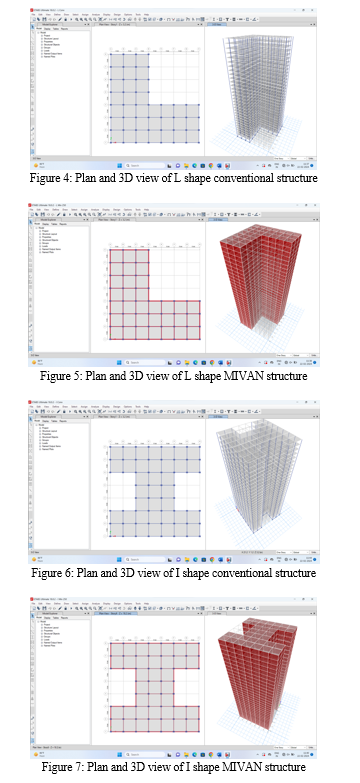
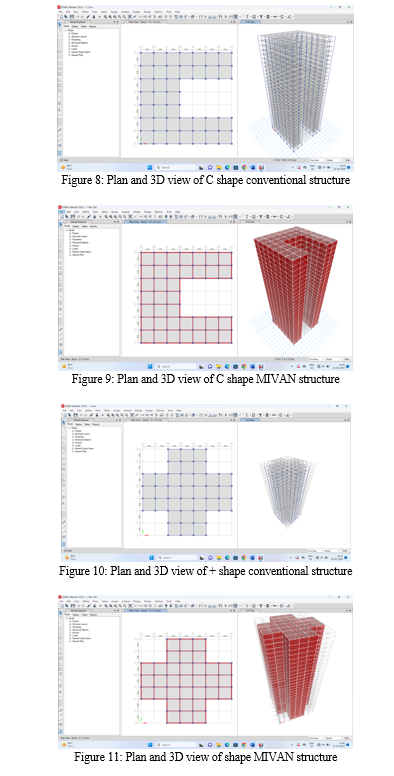

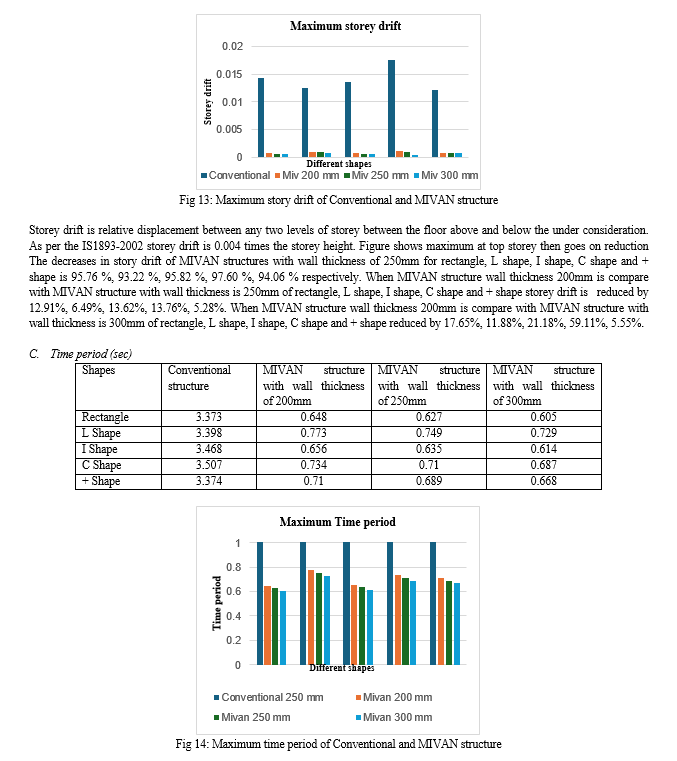
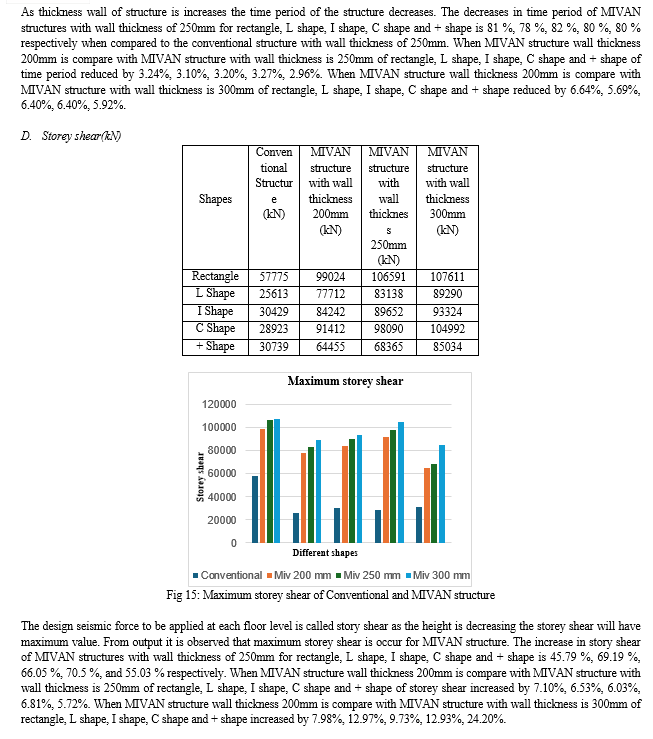

Stiffness is the extent to which an object resists deformation in response to an applied force. As the height is decreasing the storey stiffness will have maximum value. From output it is observed that maximum storey stiffness is occur for MIVAN structure. The increase in story stiffness of MIVAN structures with wall thickness of 250mm for rectangle, L shape, I shape, C shape and + shape is 97.74 %, 97.72 %, 97.97 %, 98.0%, and 97.73 % respectively. When MIVAN structure wall thickness 200mm is compare with MIVAN structure with wall thickness is 250mm of rectangle, L shape, I shape, C shape and + shape of storey stiffness increased by 12.43%, 14.03%, 14.68%, 16.03%, 13.37%. When MIVAN structure wall thickness 200mm is compare with MIVAN structure with wall thickness is 300mm of rectangle, L shape, I shape, C shape and + shape increased by 27.88%, 28.89%, 29.09%, 30.25%,28.23%.
Conclusion
The following conclusions are made based on the results obtained from the analysis of G+30 storied regular and irregular tall structure with and without MIVAN technology by using ETABS software responses in the form of maximum story displacement, maximum story drift, story shear, and story stiffness are noted: 1) MIVAN structural system is rigid and has better resistance to lateral loads. Hence MIVAN structures wall thickness of 300 mm has less displacement compared to other wall thickness of MIVAN structure. 2) Storey drift values more for MIVAN structure compared to conventional structure. 3) As the time period(sec) values for the mivan structure lower than the conventional structure. So, the mivan structure is more flexible and more mass. 4) As the height is decreasing the storey shear will have maximum value. This is due to increase in structural stiffness of shear wall as the shear wall increases the rigidity of structure leading to higher storey shear values. 5) As the height is decreasing the storey stiffness maximum value increasing. Mivan Structure with 300mm wall thickness has more storey stiffness compared to the conventional structure. From above results, conclude that MIVAN technology with wall thickness of 300mm of I shape structure will give better performance to seismic conditions in regular and irregular tall building compared to the other shapes of structures.
References
[1] IS 1893:2016 (Part-1) Criteria for earthquake resistant design of structures. [2] IS 875:2015 (Part-3) Design Loads (other than Earthquake) for Buildings and Structures-code practice. [3] IS 16700:2023 Criteria for Structural Safety of Tall Concrete Buildings [4] Nitesh Baban Patekar and A. F. Shaikh [2023] “Assessing the impact of conventional formwork and Mivan formwork on construction productivity and efficiency” https://doi.org/10.30574/wjaets.2023.9.1.0168 eISSN :2582-8266 [5] Sunny Gorivale, Prof. V.P Bhusare [2022] “STUDY ON PERFORMANCE AND ASSESSMENT OF RCC BUILDING WITH VARIOUS LOAD RESISTING SYSTEM USING DIFFERENT TYPE OF SOIL” IRJMETS Volume: 04 Issue:01 January-2022 e-ISSN: 2582-5208 [6] Mr. Nikhil S. Thote, Prof. Aditi H. Deshmukh [2022] “ANALYSIS OF FRAMED STRUCTURE VS MIVAN STRUCTURE” IRJMETS Volume: 04 Issue:01 January-2022 e-ISSN: 2582-5208 [7] Mansi Rangari, Divya wade, Ankita dandekar, Sneha Meshram, Subodh Kawale, Neha Khobragade[2022] “A review on use of MIVAN formwork in replacement with conventional formwork” (ICTTSE) ISSN: 2394 - 658X [8] Ankita Dandekar, Divya Wade, Sneha Meshram, Subodh Kawale, Mansi Rangari, Neha Khobragade[2022] “Literature study on comparision between MIVAN formwork and conventional formwork in construction” (ICTTSE) ISSN: 2394 - 658X [9] Ms. Shivani R. Barve, Prof. R. S. Ingalkar, Prof. S. Sabihuddin[2022] “Study of Modern Formwork System for Fast Track Construction” IARJSET Vol. 9, Issue 5, May 2022 [10] Kambale, Shivam Hawaldar, Sawan Patil, Amol Sonawane, Anjali Patole, Manoj Patil [2022] “Study Paper on MIVAN Technology” IJPRSE VOL.3, NO.06, JUNE 2022 [11] Darshankumar Patel a, Shubham Pawarb, Vishwadeep Pawarb, Sagar Vasaveb, Prasad Bhamareb, Nikhil Patil[2022] “A Review Paper on Comparative analysis of MIVAN Formwork Technology and Conventional Formwork Technology” IJRPR ISSN 2582-7421 [12] Javed Ul Islam, Ishfaq Ul Abass, Vivek kumar Meena, Naveen Kakrora, Sachin Meena[2021] “Comparison of Story Drift, Story Displacement & Base Shear for Different Structural System” ISSN: 2321-9939, Volume 9,IJEDR 2021 [13] Deep Jayesh Mistry, Prof. Amit D. Raval, Dr. J. R. Pitroda [2021] “Emerging Trends in Advancement of Formwork” ISSN: 2321-9653; IC Value: 45.98; SJ Impact Factor: 7.429 Volume 9 Issue III Mar 2021 [14] Sujit Shelke, Kanupriya Waghmare, Nikhil Thorat, Rohan Wadekar, Prof. Nikhil Maske [2021] “ANALYSIS OF ALUMINUM FORMWORK STRUCTURE BASED ON DURATION AND COST” (IRJET) Volume: 08 Issue: 06 June 2021 [15] Chethan M, B S Sureshchandra [2021] “Seismic Analysis Comparison of G+11 Storey Conventional RC Frame Structure and Mivan Structure” IJTSRD Volume 6 Issue 1, November-December 2021 e-ISSN: 2456 – 6470 [16] Abhijit V Bidare, Deepali Bhagaje [2021] “COMPARITIVE ANALYSIS OF CONVENTIONAL TECHNOLOGY AND MIVAN TECHNOLOGY” IRJET Volume: 08 Issue: 09 Sep 2021 e-ISSN: 2395-0056 p-ISSN: 2395-0072 [17] Anantkumar M. Patil, Vishwanath Awati, Rashmi J. V. [2020] “Comparative Analysis of Conventional Formwork and MIVAN Formwork based on Duration and Cost” IRJET Volume: 07 Issue: 06 June 2020 [18] Anuj Choubey, Savita Maru [2020] “Optimum Shape for High Rise MIVAN and Conventional Structure in Seismic Loading” (IJRTE) Volume-8 Issue-5, January 2020 [19] Pramod Shinde [2020] “A REVIEW PAPER ON FEASIBILITY OF MIVAN FORMWORK TECHNOLOGY OVER CONVENTIONAL FORMWORK TECHNOLOGY FOR CONSTRUCTION PROJECTS.” (IRJET) Volume: 07 Issue: 05, May 2020 [20] Israth Ansari Shaik, B.G. Rahul [2019] “A Critical Study on Technological Advancements of Formwork in Construction Project Management” ISSN: 2277-3878, Volume-7, Issue-6C2, April 2019 [21] Akshay Gulghane, Nikhil Pitale, Sanket Sanghai [2018] “Time and Cost Optimization of Construction Project Using MIVAN Technology” IJERA ISSN: 2248-9622, Vol. 8, Issue 8 (Part -II) Aug 2018 [22] Sudhir Shinde, Krishna Kharjule [2018] “Estimating & Cost Comparison Between Conventional and MIVAN Technique” (IJIRT) Volume 4 Issue 8 ISSN: 2349-6002 january 2018 [23] Miss. Mrunal S. Khobragade1 and Dr. A. V. Patil [2018] “Comparative Study in Analysis, Design and Material Requirement of Conventional Structural System and Frameless R.C.C structural System” International Journal of Innovative Research & Studies Volume 8, Issue IV, APRIL 2018 ISSN NO: 2319-9725 [24] Deepesh Malviya Prof. Vinay Kumar Singh Chandrakar Dr. Gyanendra Singh Prof. Praveen Singh Tomar [2017] “Seismic Analysis of a Tall Structure for L & I Shape Geometry” IJSRD Vol. 5, Issue 09, 2017 ISSN (online): 2321-0613 [25] Miss. Renuka Hangarge, Mr. Ashish Waghmare,Mr. Shridhar Patil[2017] “Comparison of Conventional, Aluminum and Tunnel Formwork” IJSRP , Volume 7, Issue 1, January 2017 176 ISSN 2250-3153 [26] Hemanthkumar M S, Kiran.T[2017] “Analysis of Wind Response on Different Shapes of High Rise MIVAN Wall Buildings by Using Gust Factor Method” IRJET Volume: 04 Issue: 09 | Sep -2017 [27] Pawan M. Walvekar, Hemant L. Sonawadekar [2017] “Seismic Performance Evaluation of MIVAN Structural System v/s Conventional Structural System with Effect of SSI by Pushover Analysis” IRJET Volume: 04 Issue: 06 June -2017 [28] SS. Asadi, PV. Praneeth [2017] “A COMPARATIVE STUDY FOR EVALUATION OF DIFFERENT FORM WORK SYSTEMS UTILIZATION IN CONSTRUCTION PROJECTS” Volume 8, Issue 11, November 2017 [29] K.Loganathan , K.E.Viswanathan [2016] “A STUDY REPORT ON COST, DURATION AND QUALITY ANALYSIS OF DIFFERENT FORMWORKS IN HIGH-RISE BUILDING” Volume 7, Issue 4, April-2016 ISSN 2229-5518 [30] Kushal Patil, Ajitkumar Jadhav, Nikhil Shingate [2015] “MIVAN Technology” (IJETR) ISSN: 2321-0869, Volume-3, Issue-6, June 2015 [31] Mr.N.B.Baraskar, Prof.U.R.Kawade[2015] “Structural Performance of RC Structural wall system over conventional Beam Column System in G+15 storey Building.” International Journal of Engineering Research and General Science Volume 3, Issue 4, July-August, 2015 ISSN 2091-2730 [32] Sajeet.S.B , Supreeth S Gowda [2015] “EARTH QUAKE RESPONSE OF DIFFERENT SHAPES OF MIVAN WALL TALL BUILDINGS “ IJRET Volume: 04 Issue: 10 Oct-2015 eISSN: 2319-1163 pISSN: 2321-7308
Copyright
Copyright © 2024 M Ganga Jamuna, Dr. P Anuradha. This is an open access article distributed under the Creative Commons Attribution License, which permits unrestricted use, distribution, and reproduction in any medium, provided the original work is properly cited.

Download Paper
Paper Id : IJRASET63306
Publish Date : 2024-06-15
ISSN : 2321-9653
Publisher Name : IJRASET
DOI Link : Click Here
 Submit Paper Online
Submit Paper Online

